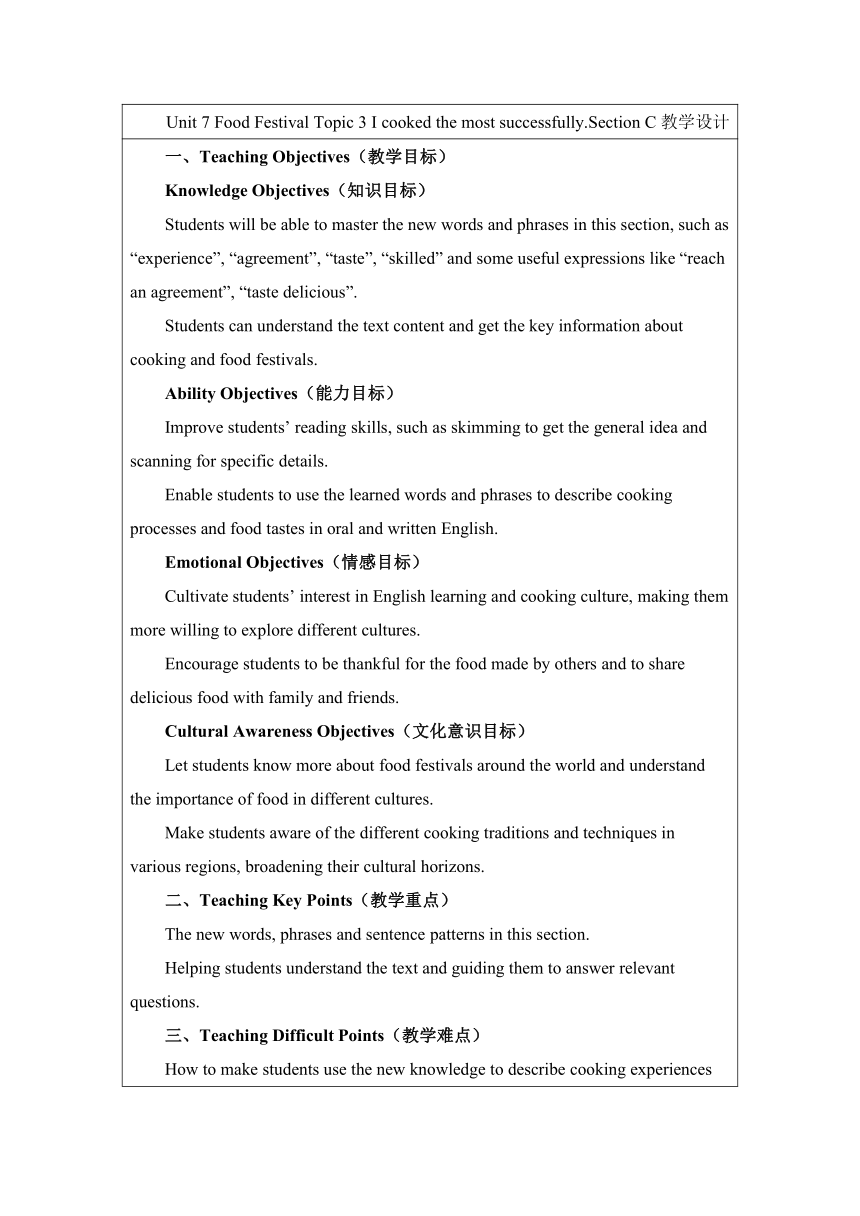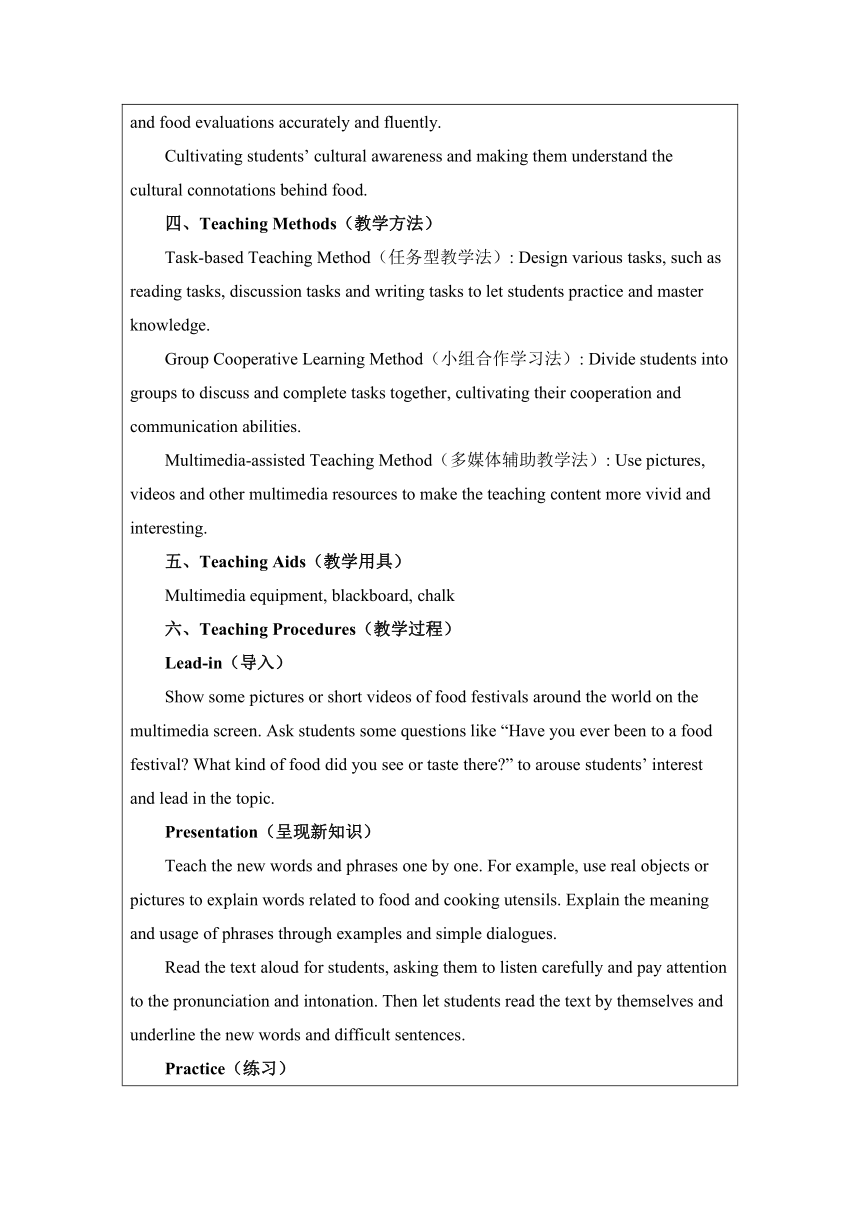仁爱版八下英语 Unit 7 Topic 3 I cooked the most successfully Section C教学设计(表格式,含核心素养目标)
文档属性
| 名称 | 仁爱版八下英语 Unit 7 Topic 3 I cooked the most successfully Section C教学设计(表格式,含核心素养目标) |  | |
| 格式 | docx | ||
| 文件大小 | 16.4KB | ||
| 资源类型 | 教案 | ||
| 版本资源 | 仁爱科普版 | ||
| 科目 | 英语 | ||
| 更新时间 | 2025-01-09 19:08:15 | ||
图片预览


文档简介
Unit 7 Food Festival Topic 3 I cooked the most successfully.Section C教学设计
一、Teaching Objectives(教学目标) Knowledge Objectives(知识目标) Students will be able to master the new words and phrases in this section, such as “experience”, “agreement”, “taste”, “skilled” and some useful expressions like “reach an agreement”, “taste delicious”. Students can understand the text content and get the key information about cooking and food festivals. Ability Objectives(能力目标) Improve students’ reading skills, such as skimming to get the general idea and scanning for specific details. Enable students to use the learned words and phrases to describe cooking processes and food tastes in oral and written English. Emotional Objectives(情感目标) Cultivate students’ interest in English learning and cooking culture, making them more willing to explore different cultures. Encourage students to be thankful for the food made by others and to share delicious food with family and friends. Cultural Awareness Objectives(文化意识目标) Let students know more about food festivals around the world and understand the importance of food in different cultures. Make students aware of the different cooking traditions and techniques in various regions, broadening their cultural horizons. 二、Teaching Key Points(教学重点) The new words, phrases and sentence patterns in this section. Helping students understand the text and guiding them to answer relevant questions. 三、Teaching Difficult Points(教学难点) How to make students use the new knowledge to describe cooking experiences and food evaluations accurately and fluently. Cultivating students’ cultural awareness and making them understand the cultural connotations behind food. 四、Teaching Methods(教学方法) Task-based Teaching Method(任务型教学法): Design various tasks, such as reading tasks, discussion tasks and writing tasks to let students practice and master knowledge. Group Cooperative Learning Method(小组合作学习法): Divide students into groups to discuss and complete tasks together, cultivating their cooperation and communication abilities. Multimedia-assisted Teaching Method(多媒体辅助教学法): Use pictures, videos and other multimedia resources to make the teaching content more vivid and interesting. 五、Teaching Aids(教学用具) Multimedia equipment, blackboard, chalk 六、Teaching Procedures(教学过程) Lead-in(导入) Show some pictures or short videos of food festivals around the world on the multimedia screen. Ask students some questions like “Have you ever been to a food festival What kind of food did you see or taste there ” to arouse students’ interest and lead in the topic. Presentation(呈现新知识) Teach the new words and phrases one by one. For example, use real objects or pictures to explain words related to food and cooking utensils. Explain the meaning and usage of phrases through examples and simple dialogues. Read the text aloud for students, asking them to listen carefully and pay attention to the pronunciation and intonation. Then let students read the text by themselves and underline the new words and difficult sentences. Practice(练习) Design some reading comprehension exercises, such as True or False questions, multiple-choice questions and filling in the blanks according to the text, to help students understand the details of the text. Divide students into groups. Each group is given a task to describe a cooking process or a food they like using the new words and phrases they have learned. Then ask some groups to report their descriptions in front of the class. Production(产出) Set a writing task for students. Let them write a short passage about their own cooking experiences or their favorite food festival, requiring them to use at least five new words and phrases learned in this section. After students finish writing, ask them to exchange papers with their partners and correct each other’s mistakes. Then select some excellent works to read aloud in class and give praise and comments. Summary(总结) Summarize the key points of this lesson with students, including the new words, phrases, sentence patterns and the main content of the text. Emphasize the importance of learning English for understanding different cultures and remind students to practice using English in daily life. Homework(作业) Ask students to review the new knowledge learned in class and recite the text. Let students search for more information about food festivals in different countries on the Internet and make a simple report to share with the class next time. 七、Blackboard Design(板书设计) On the left side of the blackboard, write down the new words and phrases. In the middle, write down some important sentence patterns and examples. On the right side, write down the key points and steps of the writing task. 八、Teaching Reflection(教学反思) After the class, think about whether the teaching objectives have been achieved, whether the teaching methods are appropriate, and whether students have actively participated in the learning process. Analyze the problems and difficulties encountered by students during the class and make corresponding adjustments and improvements for the next teaching.
一、Teaching Objectives(教学目标) Knowledge Objectives(知识目标) Students will be able to master the new words and phrases in this section, such as “experience”, “agreement”, “taste”, “skilled” and some useful expressions like “reach an agreement”, “taste delicious”. Students can understand the text content and get the key information about cooking and food festivals. Ability Objectives(能力目标) Improve students’ reading skills, such as skimming to get the general idea and scanning for specific details. Enable students to use the learned words and phrases to describe cooking processes and food tastes in oral and written English. Emotional Objectives(情感目标) Cultivate students’ interest in English learning and cooking culture, making them more willing to explore different cultures. Encourage students to be thankful for the food made by others and to share delicious food with family and friends. Cultural Awareness Objectives(文化意识目标) Let students know more about food festivals around the world and understand the importance of food in different cultures. Make students aware of the different cooking traditions and techniques in various regions, broadening their cultural horizons. 二、Teaching Key Points(教学重点) The new words, phrases and sentence patterns in this section. Helping students understand the text and guiding them to answer relevant questions. 三、Teaching Difficult Points(教学难点) How to make students use the new knowledge to describe cooking experiences and food evaluations accurately and fluently. Cultivating students’ cultural awareness and making them understand the cultural connotations behind food. 四、Teaching Methods(教学方法) Task-based Teaching Method(任务型教学法): Design various tasks, such as reading tasks, discussion tasks and writing tasks to let students practice and master knowledge. Group Cooperative Learning Method(小组合作学习法): Divide students into groups to discuss and complete tasks together, cultivating their cooperation and communication abilities. Multimedia-assisted Teaching Method(多媒体辅助教学法): Use pictures, videos and other multimedia resources to make the teaching content more vivid and interesting. 五、Teaching Aids(教学用具) Multimedia equipment, blackboard, chalk 六、Teaching Procedures(教学过程) Lead-in(导入) Show some pictures or short videos of food festivals around the world on the multimedia screen. Ask students some questions like “Have you ever been to a food festival What kind of food did you see or taste there ” to arouse students’ interest and lead in the topic. Presentation(呈现新知识) Teach the new words and phrases one by one. For example, use real objects or pictures to explain words related to food and cooking utensils. Explain the meaning and usage of phrases through examples and simple dialogues. Read the text aloud for students, asking them to listen carefully and pay attention to the pronunciation and intonation. Then let students read the text by themselves and underline the new words and difficult sentences. Practice(练习) Design some reading comprehension exercises, such as True or False questions, multiple-choice questions and filling in the blanks according to the text, to help students understand the details of the text. Divide students into groups. Each group is given a task to describe a cooking process or a food they like using the new words and phrases they have learned. Then ask some groups to report their descriptions in front of the class. Production(产出) Set a writing task for students. Let them write a short passage about their own cooking experiences or their favorite food festival, requiring them to use at least five new words and phrases learned in this section. After students finish writing, ask them to exchange papers with their partners and correct each other’s mistakes. Then select some excellent works to read aloud in class and give praise and comments. Summary(总结) Summarize the key points of this lesson with students, including the new words, phrases, sentence patterns and the main content of the text. Emphasize the importance of learning English for understanding different cultures and remind students to practice using English in daily life. Homework(作业) Ask students to review the new knowledge learned in class and recite the text. Let students search for more information about food festivals in different countries on the Internet and make a simple report to share with the class next time. 七、Blackboard Design(板书设计) On the left side of the blackboard, write down the new words and phrases. In the middle, write down some important sentence patterns and examples. On the right side, write down the key points and steps of the writing task. 八、Teaching Reflection(教学反思) After the class, think about whether the teaching objectives have been achieved, whether the teaching methods are appropriate, and whether students have actively participated in the learning process. Analyze the problems and difficulties encountered by students during the class and make corresponding adjustments and improvements for the next teaching.
同课章节目录
- Unit 5 Feeling excited
- Topic 1 You look excited
- Topic 2 I’m feeling better now.
- Topic 3 Many things can affect our feelings.
- Unit 6 Enjoying Cycling
- Topic 1 We're going on a three-day visit to Mount
- Topic 2 How about exploring Tian’anmen Square?
- Topic 3 Bicycle riding is good exercise.
- Unit 7 Food festival
- Topic 1 We’re preparing for a food festival.
- Topic 2 I’m not sure whether I can cook it well.
- Topic 3 I Cooked the Most Successfully
- Unit 8 Our Clothes
- Topic 1 We will have a class fashion show.
- Topic 2 We can design our own uniforms.
- Topic 3 He said the fashion show was wonderful.
